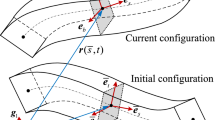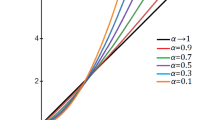Abstract
Complex helical structures are difficult to model in three-dimensional form to conduct finite element analysis. In general, parametric mathematical equations for single and double helical geometries are readily available in existing literature. However, more complex forms such as triple or in general n-tuple helical structures are still not widely studied. In this paper, at first, definitions of single and double helical structures are presented in parametric mathematical forms. Centerlines, curvatures, and torsions of these geometries are found, and these two helical geometries are visualized in three-dimensional structures. Next, one of the untouched helical models, the triple helical geometry, is investigated and a procedure to find the centerline of the triple helical geometry is presented. In addition, the first three-dimensional generated solid model of a triple helix geometry is presented. Finally, the steps used to create triple helix geometry are generalized to find parametric mathematical equations for n-tuple helical geometries.












Similar content being viewed by others
References
Love AEH (1944) A treatise on the mathematical theory of elasticity, 4th edn. Dover Publ., New York. First Am. Print. 1944, Chapter XVIII–XIX, pp 381–426
Timoshenko S (1955) Strength of materials, vol 2. Van Nostrand, New York, pp 292–299
Green AE, Laws N (1966) A general theory of rods. Proc R Soc Lond Ser A Math Phys Sci 293(1433):145–155
Hruska FH (1951) Calculation of stresses in wire ropes. Wire Wire Prod 26(9):766–767
Costello GA (1990) Theory of wire rope. Springer, Berlin
Cochran JE Jr, Fitz-Coy NG, Cutchins MA (1987) Finite element models of wire rope for vibration analysis. NASA Marshall Space Flight Cent., NTRS: 2007-06-26, Number: 87N22748; ID: 19870013315
Chiang YJ (1996) Characterizing simple stranded wire cables under axial loading. Finite Elem Anal Des 24:49–66
Jiang WG, Henshall JL (1999) The analysis of termination effects in wire strand using finite element method. J Strain Anal 34(1):31–38
Jiang WG, Yao MS, Walton JM (1999) A concise finite element model for simple straight wire rope strand. Int J Mech Sci 41:143–161
Jiang WG, Henshall JL, Walton JM (2000) A concise finite element model for three-layered straight wire rope strand. Int J Mech Sci 42:63–86
Erdönmez C, İmrak CE (2011) A finite element model for independent wire rope core with double helical geometry subjected to axial loads. Sadhana Acad Proc Eng Sci 36(6):995–1008
Erdönmez C, İmrak CE (2011) Modeling techniques of nested helical structure based geometry for numerical analysis. Stroj Vestn J Mech Eng 57(4):283–292. doi:10.5545/sv-jme.2009.006
Andorfer K (1983) Die Zugkraftverteilung in schwingend beanspruchten geraden Drahtseilen. Diss. Tech. Univ. Graz
Lee WK (1991) An insight into wire rope geometry. Int J Solids Struct 28(4):471–490
Wang RC, Miscoe AJ, McKewan WM (1998) Model for the structure of round-strand wire ropes, vol 9644. U.S. Dep. Health Hum. Serv., Public Health Serv., Cent. Disease Control Prev., Natl. Inst. Occup. Saf. Health, DHHS (NIOSH), Publ. No. 98–148, Rep. Investig, pp 1–19
Usabiaga H, Pagalday JM (2008) Analytical procedure for modelling recursively and wire by wire stranded ropes subjected to traction and torsion loads. Int J Solids Struct 45(21):5503–5520
Acknowledgments
This study was supported by the Scientific and Technological Research Council of Turkey (TUBITAK) with the Grant Number (BIDEB-2219).
Author information
Authors and Affiliations
Corresponding author
Rights and permissions
About this article
Cite this article
Erdönmez, C. n-tuple complex helical geometry modeling using parametric equations. Engineering with Computers 30, 715–726 (2014). https://doi.org/10.1007/s00366-013-0319-9
Received:
Accepted:
Published:
Issue Date:
DOI: https://doi.org/10.1007/s00366-013-0319-9




